fuel pressure Seat Altea XL 2010 User Guide
[x] Cancel search | Manufacturer: SEAT, Model Year: 2010, Model line: Altea XL, Model: Seat Altea XL 2010Pages: 312, PDF Size: 8.41 MB
Page 249 of 312
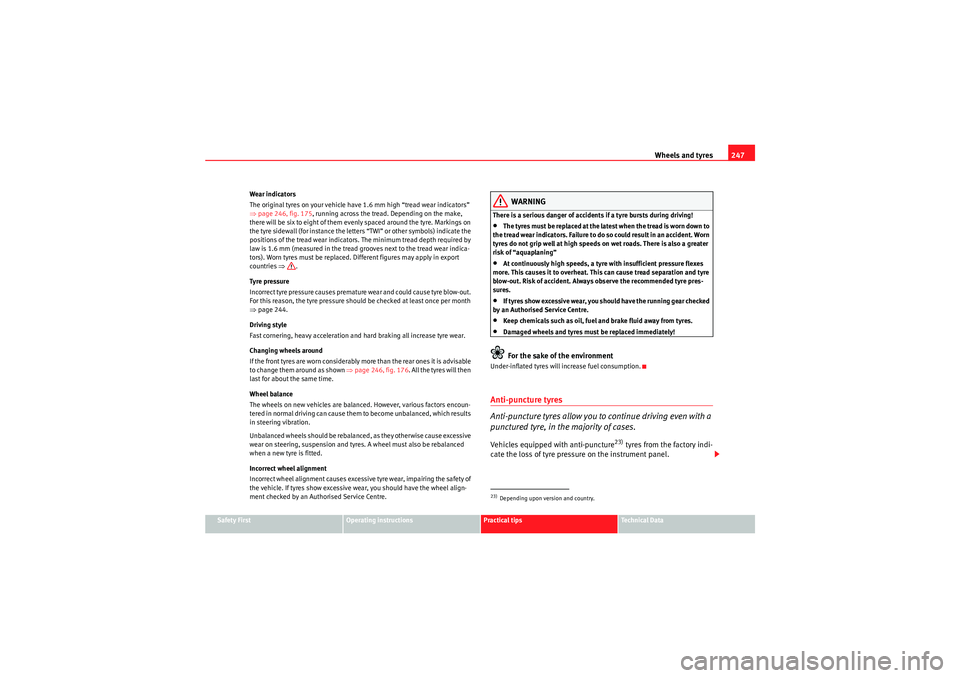
Wheels and tyres247
Safety First
Operating instructions
Practical tips
Technical Data
Wear indicators
The original tyres on your vehicle have 1.6 mm high “tread wear indicators”
⇒
page 246, fig. 175 , running across the tread. Depending on the make,
there will be six to eight of them evenly spaced around the tyre. Markings on
the tyre sidewall (for instance the letters “TWI” or other symbols) indicate the
positions of the tread wear indicators. The minimum tread depth required by
law is 1.6 mm (measured in the tread grooves next to the tread wear indica-
tors). Worn tyres must be replaced. Different figures may apply in export
countries ⇒.
Tyre pressure
Incorrect tyre pressure causes premature wear and could cause tyre blow-out.
For this reason, the tyre pressure should be checked at least once per month
⇒ page 244.
Driving style
Fast cornering, heavy acceleration and hard braking all increase tyre wear.
Changing wheels around
If the front tyres are worn considerably more than the rear ones it is advisable
to cha nge t he m ar oun d as sh own ⇒ page 246, fig. 176. All the tyres will then
last for about the same time.
Wheel balance
The wheels on new vehicles are balanced. However, various factors encoun-
tered in normal driving can cause them to become unbalanced, which results
in steering vibration.
Unbalanced wheels should be rebalanced, as they otherwise cause excessive
wear on steering, suspension and tyres. A wheel must also be rebalanced
when a new tyre is fitted.
Incorrect wheel alignment
Incorrect wheel alignment causes excessive tyre wear, impairing the safety of
the vehicle. If tyres show excessive wear, you should have the wheel align-
ment checked by an Authorised Service Centre.
WARNING
There is a serious danger of accidents if a tyre bursts during driving!•The tyres must be replaced at the latest when the tread is worn down to
the tread wear indicators. Failure to do so could result in an accident. Worn
tyres do not grip well at high speeds on wet roads. There is also a greater
risk of “aquaplaning” •At continuously high speeds, a tyre with insufficient pressure flexes
more. This causes it to overheat. This can cause tread separation and tyre
blow-out. Risk of accident. Always observe the recommended tyre pres-
sures.•If tyres show excessive wear, you should have the running gear checked
by an Authorised Service Centre.•Keep chemicals such as oil, fuel and brake fluid away from tyres.•Damaged wheels and tyres must be replaced immediately!For the sake of the environment
Under-inflated tyres will increase fuel consumption.Anti-puncture tyres
Anti-puncture tyres allow you to continue driving even with a
punctured tyre, in the majority of cases.Vehicles equipped with anti-puncture
23) tyres from the factory indi-
cate the loss of tyre pressure on the instrument panel.
23)Depending upon version and country.
AlteaXL_EN.book Seite 247 Dienstag, 1. September 2009 10:37 10
Page 250 of 312
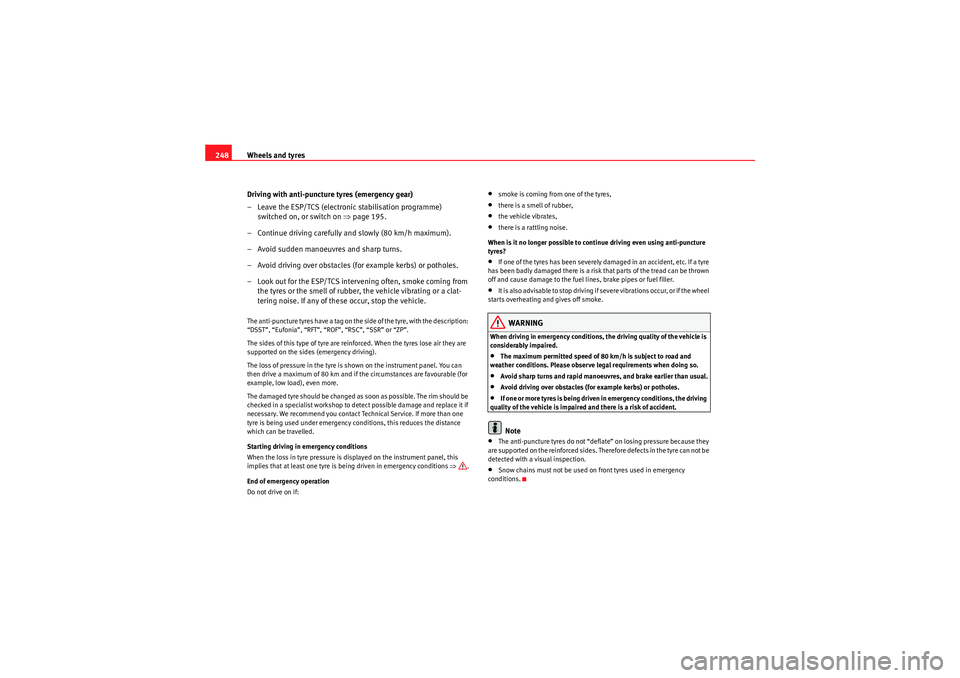
Wheels and tyres
248
Driving with anti-puncture tyres (emergency gear)
– Leave the ESP/TCS (electronic stabilisation programme) switched on, or switch on ⇒page 195.
– Continue driving carefully and slowly (80 km/h maximum).
– Avoid sudden manoeuvres and sharp turns.
– Avoid driving over obstacles (for example kerbs) or potholes.
– Look out for the ESP/TCS intervening often, smoke coming from the tyres or the smell of rubber, the vehicle vibrating or a clat-
tering noise. If any of these occur, stop the vehicle.The anti-puncture tyres have a tag on the side of the tyre, with the description:
“DSST”, “Eufonia”, “RFT”, “ROF”, “RSC”, “SSR” or “ZP”.
The sides of this type of tyre are reinforced. When the tyres lose air they are
supported on the sides (emergency driving).
The loss of pressure in the tyre is shown on the instrument panel. You can
then drive a maximum of 80 km and if the circumstances are favourable (for
example, low load), even more.
The damaged tyre should be changed as soon as possible. The rim should be
checked in a specialist workshop to detect possible damage and replace it if
necessary. We recommend you contact Technical Service. If more than one
tyre is being used under emergency co nditions, this reduces the distance
which can be travelled.
Starting driving in emergency conditions
When the loss in tyre pressure is displayed on the instrument panel, this
implies that at least one tyre is being driven in emergency conditions ⇒.
End of emergency operation
Do not drive on if:
•smoke is coming from one of the tyres,•there is a smell of rubber,•the vehicle vibrates,•there is a rattling noise.
When is it no longer possible to continue driving even using anti-puncture
tyres?•If one of the tyres has been severely damaged in an accident, etc. If a tyre
has been badly damaged there is a risk that parts of the tread can be thrown
off and cause damage to the fuel lines, brake pipes or fuel filler.•It is also advisable to stop driving if severe vibrations occur, or if the wheel
starts overheating and gives off smoke.WARNING
When driving in emergency conditions, the driving quality of the vehicle is
considerably impaired.•The maximum permitted speed of 80 km/h is subject to road and
weather conditions. Please observe legal requirements when doing so.•Avoid sharp turns and rapid manoeuvres, and brake earlier than usual.•Avoid driving over obstacles (for example kerbs) or potholes.•If one or more tyres is being driven in emergency conditions, the driving
quality of the vehicle is impaired and there is a risk of accident.Note
•The anti-puncture tyres do not “deflate” on losing pressure because they
are supported on the reinforced sides. Therefore defects in the tyre can not be
detected with a visual inspection.•Snow chains must not be used on front tyres used in emergency
conditions.
AlteaXL_EN.book Seite 248 Dienstag, 1. September 2009 10:37 10
Page 255 of 312
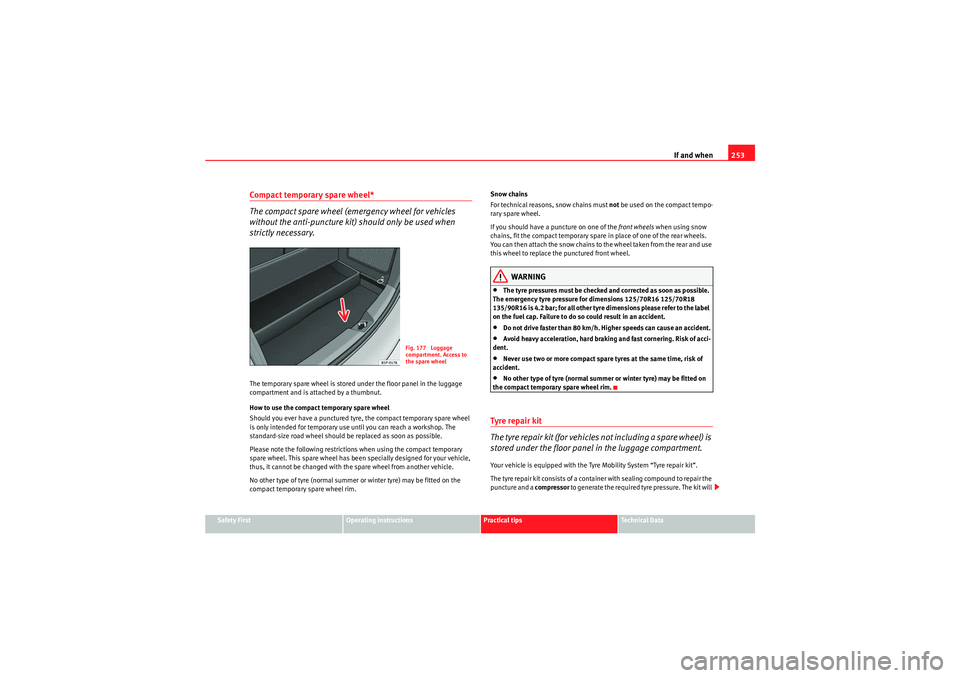
If and when253
Safety First
Operating instructions
Practical tips
Technical Data
Compact temporary spare wheel*
The compact spare wheel (emergency wheel for vehicles
without the anti-puncture kit) should only be used when
strictly necessary.The temporary spare wheel is stored under the floor panel in the luggage
compartment and is attached by a thumbnut.
How to use the compact temporary spare wheel
Should you ever have a punctured tyre, the compact temporary spare wheel
is only intended for temporary use until you can reach a workshop. The
standard-size road wheel should be replaced as soon as possible.
Please note the following restrictions when using the compact temporary
spare wheel. This spare wheel has been specially designed for your vehicle,
thus, it cannot be changed with the spare wheel from another vehicle.
No other type of tyre (normal summer or winter tyre) may be fitted on the
compact temporary spare wheel rim. Snow chains
For technical reasons, snow chains must
not be used on the compact tempo-
rary spare wheel.
If you should have a puncture on one of the front wheels when using snow
chains, fit the compact temporary spare in place of one of the rear wheels.
You can then attach the snow chains to the wheel taken from the rear and use
this wheel to replace the punctured front wheel.
WARNING
•The tyre pressures must be checked and corrected as soon as possible.
The emergency tyre pressure for dimensions 125/70R16 125/70R18
135/90R16 is 4.2 bar; for all other tyre dimensions please refer to the label
on the fuel cap. Failure to do so could result in an accident.•Do not drive faster than 80 km/h. Higher speeds can cause an accident.•Avoid heavy acceleration, hard braking and fast cornering. Risk of acci-
dent.•Never use two or more compact spare tyres at the same time, risk of
accident.•No other type of tyre (normal summer or winter tyre) may be fitted on
the compact temporary spare wheel rim.
Tyre repair kit
The tyre repair kit (for vehicles not including a spare wheel) is
stored under the floor panel in the luggage compartment.Your vehicle is equipped with the Tyre Mobility System “Tyre repair kit”.
The tyre repair kit consists of a container with sealing compound to repair the
puncture and a compressor to generate the required tyre pressure. The kit will
Fig. 177 Luggage
compartment. Access to
the spare wheel
AlteaXL_EN.book Seite 253 Dienstag, 1. September 2009 10:37 10
Page 281 of 312
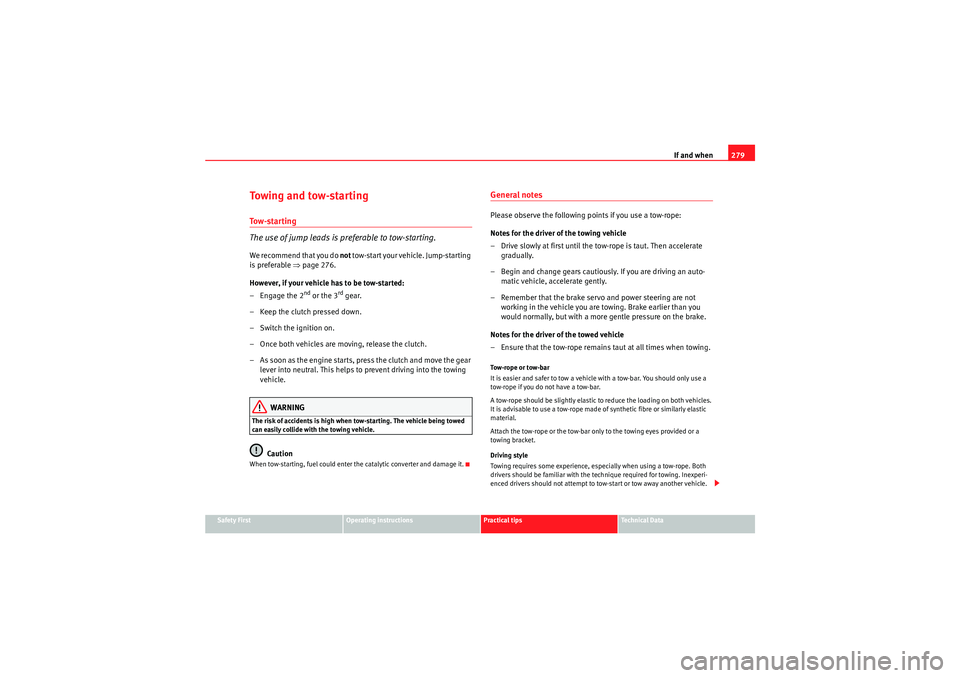
If and when279
Safety First
Operating instructions
Practical tips
Technical Data
Towing and tow-startingTo w - s t a r t i n g
The use of jump leads is pr eferable to tow-starting.We recommend that you do not tow-start your vehicle. Jump-starting
is preferable ⇒page 276.
However, if your vehicle has to be tow-started:
– Engage the 2
nd or the 3
rd gear.
– Keep the clutch pressed down.
– Switch the ignition on.
– Once both vehicles are moving, release the clutch.
– As soon as the engine starts, press the clutch and move the gear lever into neutral. This helps to prevent driving into the towing
vehicle.
WARNING
The risk of accidents is high when tow-starting. The vehicle being towed
can easily collide with the towing vehicle.
Caution
When tow-starting, fuel could enter the catalytic converter and damage it.
General notesPlease observe the following po ints if you use a tow-rope:
Notes for the driver of the towing vehicle
– Drive slowly at first until the tow-rope is taut. Then accelerate gradually.
– Begin and change gears cautiously. If you are driving an auto- matic vehicle, accelerate gently.
– Remember that the brake servo and power steering are not working in the vehicle you are towing. Brake earlier than you
would normally, but with a more gentle pressure on the brake.
Notes for the driver of the towed vehicle
– Ensure that the tow-rope remains taut at all times when towing.Tow-rope or tow-bar
It is easier and safer to tow a vehicle with a tow-bar. You should only use a
tow-rope if you do not have a tow-bar.
A tow-rope should be slightly elastic to reduce the loading on both vehicles.
It is advisable to use a tow-rope made of synthetic fibre or similarly elastic
material.
Attach the tow-rope or the tow-bar only to the towing eyes provided or a
towing bracket.
Driving style
Towing requires some experience, especially when using a tow-rope. Both
drivers should be familiar with the technique required for towing. Inexperi-
enced drivers should not attempt to tow-start or tow away another vehicle.
AlteaXL_EN.book Seite 279 Dienstag, 1. September 2009 10:37 10
Page 302 of 312
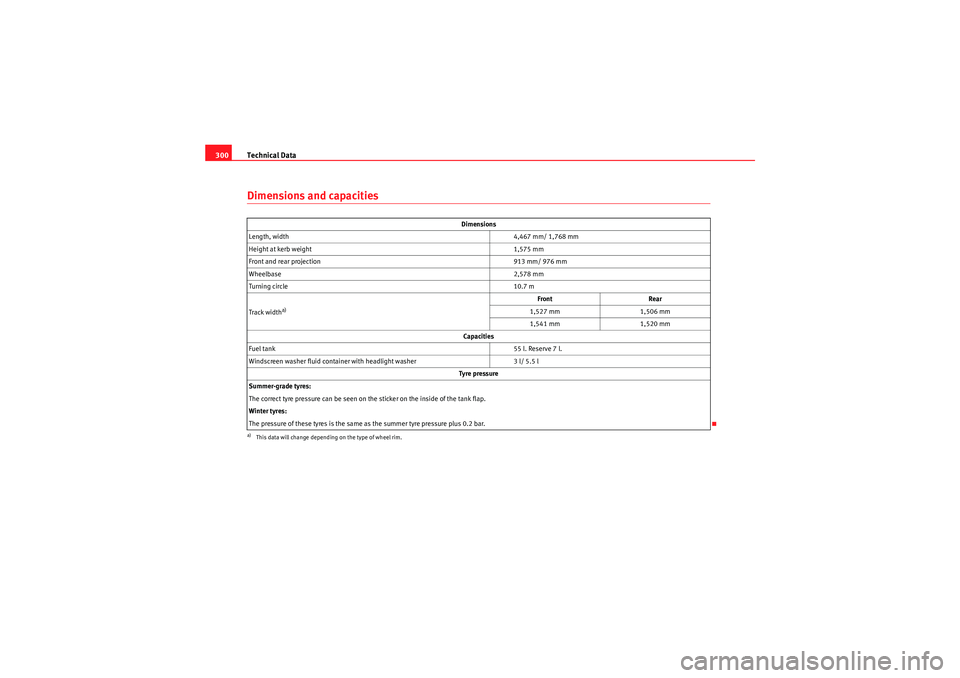
Technical Data
300Dimensions and capacities
Dimensions
Length, width 4,467 mm/ 1,768 mm
Height at kerb weight 1,575 mm
Front and rear projection 913 mm/ 976 mm
Wheelbase 2,578 mm
Turning circle 10.7 m
Track width
a)
a)This data will change depending on the type of wheel rim.
Front Rear
1,527 mm 1,506 mm
1,541 mm 1,520 mm
Capacities
Fuel tank 55 l. Reserve 7 l.
Windscreen washer fluid container with headlight washer 3 l/ 5.5 l
Ty re p re ss u re
Summer-grade tyres:
The correct tyre pressure can be seen on the sticker on the inside of the tank flap.
Winter tyres:
The pressure of these tyres is the same as the summer tyre pressure plus 0.2 bar.
AlteaXL_EN.book Seite 300 Dienstag, 1. September 2009 10:37 10
Page 306 of 312
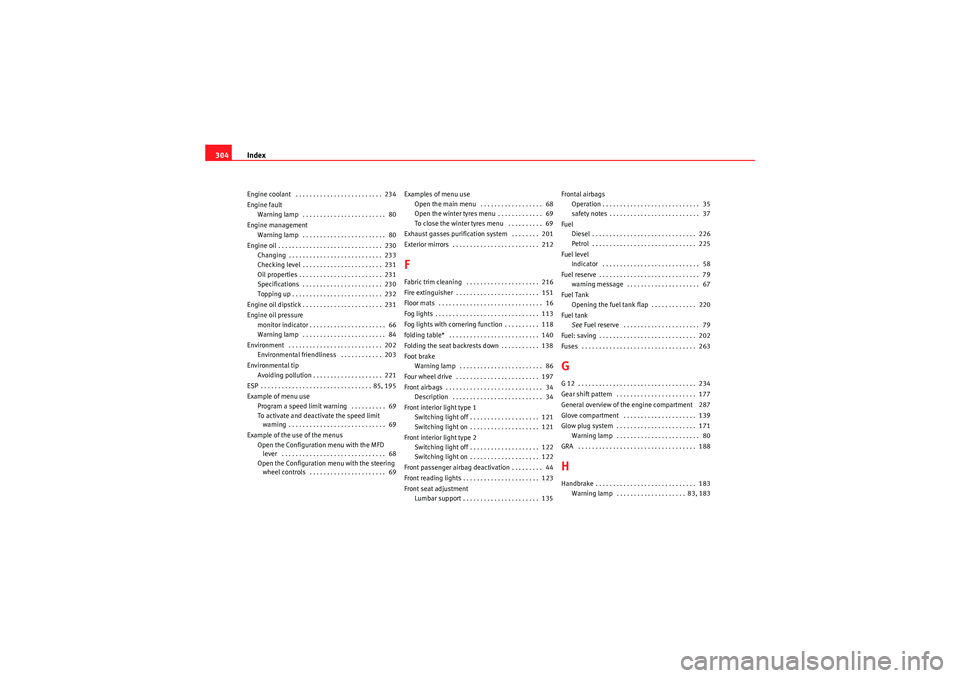
Index
304Engine coolant . . . . . . . . . . . . . . . . . . . . . . . . . 234
Engine fault
Warning lamp . . . . . . . . . . . . . . . . . . . . . . . . 80
Engine management Warning lamp . . . . . . . . . . . . . . . . . . . . . . . . 80
Engine oil . . . . . . . . . . . . . . . . . . . . . . . . . . . . . . 230 Changing . . . . . . . . . . . . . . . . . . . . . . . . . . . 233
Checking level . . . . . . . . . . . . . . . . . . . . . . . 231
Oil properties . . . . . . . . . . . . . . . . . . . . . . . . 231
Specifications . . . . . . . . . . . . . . . . . . . . . . . 230
Topping up . . . . . . . . . . . . . . . . . . . . . . . . . . 232
Engine oil dipstick . . . . . . . . . . . . . . . . . . . . . . . 231
Engine oil pressure monitor indicator . . . . . . . . . . . . . . . . . . . . . . 66
Warning lamp . . . . . . . . . . . . . . . . . . . . . . . . 84
Environment . . . . . . . . . . . . . . . . . . . . . . . . . . . 202 Environmental friendliness . . . . . . . . . . . . 203
Environmental tip Avoiding pollution . . . . . . . . . . . . . . . . . . . . 221
ESP . . . . . . . . . . . . . . . . . . . . . . . . . . . . . . . . 85, 195
Example of menu use Program a speed limit warning . . . . . . . . . . 69
To activate and deactivate the speed limit warning . . . . . . . . . . . . . . . . . . . . . . . . . . . . 69
Example of the use of the menus Open the Configuration menu with the MFD lever . . . . . . . . . . . . . . . . . . . . . . . . . . . . . . 68
Open the Configuration menu with the steering wheel controls . . . . . . . . . . . . . . . . . . . . . . 69 Examples of menu use
Open the main menu . . . . . . . . . . . . . . . . . . 68
Open the winter tyres menu . . . . . . . . . . . . . 69
To close the winter tyres menu . . . . . . . . . . 69
Exhaust gasses purification system . . . . . . . . 201
Exterior mirrors . . . . . . . . . . . . . . . . . . . . . . . . . 212
FFabric trim cleaning . . . . . . . . . . . . . . . . . . . . . 216
Fire extinguisher . . . . . . . . . . . . . . . . . . . . . . . . 151
Floor mats . . . . . . . . . . . . . . . . . . . . . . . . . . . . . . 16
Fog lights . . . . . . . . . . . . . . . . . . . . . . . . . . . . . . 113
Fog lights with cornering function . . . . . . . . . . 118
folding table* . . . . . . . . . . . . . . . . . . . . . . . . . . 140
Folding the seat backrests down . . . . . . . . . . . 138
Foot brake Warning lamp . . . . . . . . . . . . . . . . . . . . . . . . 86
Four wheel drive . . . . . . . . . . . . . . . . . . . . . . . . 197
Front airbags . . . . . . . . . . . . . . . . . . . . . . . . . . . . 34 Description . . . . . . . . . . . . . . . . . . . . . . . . . . 34
Front interior light type 1 Switching light off . . . . . . . . . . . . . . . . . . . . 121
Switching light on . . . . . . . . . . . . . . . . . . . . 121
Front interior light type 2 Switching light off . . . . . . . . . . . . . . . . . . . . 122
Switching light on . . . . . . . . . . . . . . . . . . . . 122
Front passenger airbag deactivation . . . . . . . . . 44
Front reading lights . . . . . . . . . . . . . . . . . . . . . . 123
Front seat adjustment Lumbar support . . . . . . . . . . . . . . . . . . . . . . 135 Frontal airbags
Operation . . . . . . . . . . . . . . . . . . . . . . . . . . . . 35
safety notes . . . . . . . . . . . . . . . . . . . . . . . . . . 37
Fuel Diesel . . . . . . . . . . . . . . . . . . . . . . . . . . . . . . 226
Petrol . . . . . . . . . . . . . . . . . . . . . . . . . . . . . . 225
Fuel level Indicator . . . . . . . . . . . . . . . . . . . . . . . . . . . . 58
Fuel reserve . . . . . . . . . . . . . . . . . . . . . . . . . . . . . 79 warning message . . . . . . . . . . . . . . . . . . . . . 67
Fuel Tank Opening the fuel tank flap . . . . . . . . . . . . . 220
Fuel tank See Fuel reserve . . . . . . . . . . . . . . . . . . . . . . 79
Fuel: saving . . . . . . . . . . . . . . . . . . . . . . . . . . . . 202
Fuses . . . . . . . . . . . . . . . . . . . . . . . . . . . . . . . . . 263
GG 12 . . . . . . . . . . . . . . . . . . . . . . . . . . . . . . . . . . 234
Gear shift pattern . . . . . . . . . . . . . . . . . . . . . . . 177
General overview of the engine compartment 287
Glove compartment . . . . . . . . . . . . . . . . . . . . . 139
Glow plug system . . . . . . . . . . . . . . . . . . . . . . . 171 Warning lamp . . . . . . . . . . . . . . . . . . . . . . . . 80
GRA . . . . . . . . . . . . . . . . . . . . . . . . . . . . . . . . . . 188HHandbrake . . . . . . . . . . . . . . . . . . . . . . . . . . . . . 183 Warning lamp . . . . . . . . . . . . . . . . . . . . 83, 183
AlteaXL_EN.book Seite 304 Dienstag, 1. September 2009 10:37 10
Page 307 of 312
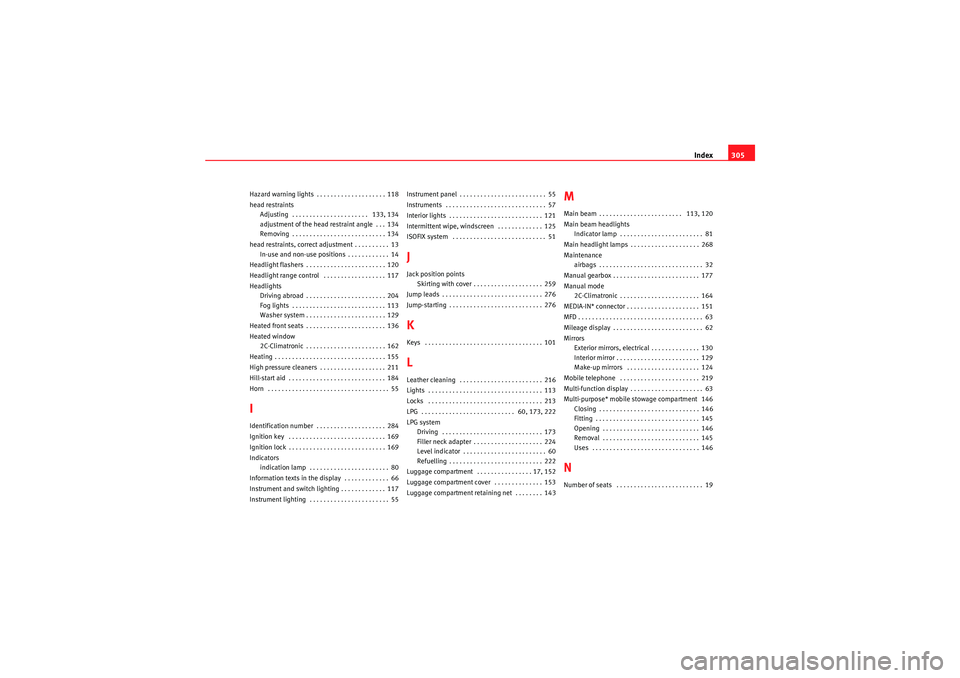
Index305
Hazard warning lights . . . . . . . . . . . . . . . . . . . . 118
head restraints
Adjusting . . . . . . . . . . . . . . . . . . . . . . 133, 134
adjustment of the head restraint angle . . . 134
Removing . . . . . . . . . . . . . . . . . . . . . . . . . . . 134
head restraints, correct adjustment . . . . . . . . . . 13 In-use and non-use positions . . . . . . . . . . . . 14
Headlight flashers . . . . . . . . . . . . . . . . . . . . . . . 120
Headlight range control . . . . . . . . . . . . . . . . . . 117
Headlights Driving abroad . . . . . . . . . . . . . . . . . . . . . . . 204
Fog lights . . . . . . . . . . . . . . . . . . . . . . . . . . . 113
Washer system . . . . . . . . . . . . . . . . . . . . . . . 129
Heated front seats . . . . . . . . . . . . . . . . . . . . . . . 136
Heated window 2C-Climatronic . . . . . . . . . . . . . . . . . . . . . . . 162
Heating . . . . . . . . . . . . . . . . . . . . . . . . . . . . . . . . 155
High pressure cleaners . . . . . . . . . . . . . . . . . . . 211
Hill-start aid . . . . . . . . . . . . . . . . . . . . . . . . . . . . 184
Horn . . . . . . . . . . . . . . . . . . . . . . . . . . . . . . . . . . . 55IIdentification number . . . . . . . . . . . . . . . . . . . . 284
Ignition key . . . . . . . . . . . . . . . . . . . . . . . . . . . . 169
Ignition lock . . . . . . . . . . . . . . . . . . . . . . . . . . . . 169
Indicators indication lamp . . . . . . . . . . . . . . . . . . . . . . . 80
Information texts in the display . . . . . . . . . . . . . 66
Instrument and switch lighting . . . . . . . . . . . . . 117
Instrument lighting . . . . . . . . . . . . . . . . . . . . . . . 55 Instrument panel . . . . . . . . . . . . . . . . . . . . . . . . . 55
Instruments . . . . . . . . . . . . . . . . . . . . . . . . . . . . . 57
Interior lights . . . . . . . . . . . . . . . . . . . . . . . . . . . 121
Intermittent wipe, windscreen . . . . . . . . . . . . . 125
ISOFIX system . . . . . . . . . . . . . . . . . . . . . . . . . . . 51
JJack position points
Skirting with cover . . . . . . . . . . . . . . . . . . . . 259
Jump leads . . . . . . . . . . . . . . . . . . . . . . . . . . . . . 276
Jump-starting . . . . . . . . . . . . . . . . . . . . . . . . . . . 276KKeys . . . . . . . . . . . . . . . . . . . . . . . . . . . . . . . . . . 101LLeather cleaning . . . . . . . . . . . . . . . . . . . . . . . . 216
Lights . . . . . . . . . . . . . . . . . . . . . . . . . . . . . . . . . 113
Locks . . . . . . . . . . . . . . . . . . . . . . . . . . . . . . . . . 213
LPG . . . . . . . . . . . . . . . . . . . . . . . . . . . 60, 173, 222
LPG system Driving . . . . . . . . . . . . . . . . . . . . . . . . . . . . . 173
Filler neck adapter . . . . . . . . . . . . . . . . . . . . 224
Level indicator . . . . . . . . . . . . . . . . . . . . . . . . 60
Refuelling . . . . . . . . . . . . . . . . . . . . . . . . . . . 222
Luggage compartment . . . . . . . . . . . . . . . . 17, 152
Luggage compartment cover . . . . . . . . . . . . . . 153
Luggage compartment retaining net . . . . . . . . 143
MMain beam . . . . . . . . . . . . . . . . . . . . . . . . 113, 120
Main beam headlights Indicator lamp . . . . . . . . . . . . . . . . . . . . . . . . 81
Main headlight lamps . . . . . . . . . . . . . . . . . . . . 268
Maintenance airbags . . . . . . . . . . . . . . . . . . . . . . . . . . . . . . 32
Manual gearbox . . . . . . . . . . . . . . . . . . . . . . . . . 177
Manual mode 2C-Climatronic . . . . . . . . . . . . . . . . . . . . . . . 164
MEDIA-IN* connector . . . . . . . . . . . . . . . . . . . . . 151
MFD . . . . . . . . . . . . . . . . . . . . . . . . . . . . . . . . . . . . 63
Mileage display . . . . . . . . . . . . . . . . . . . . . . . . . . 62
Mirrors Exterior mirrors, electrical . . . . . . . . . . . . . . 130
Interior mirror . . . . . . . . . . . . . . . . . . . . . . . . 129
Make-up mirrors . . . . . . . . . . . . . . . . . . . . . 124
Mobile telephone . . . . . . . . . . . . . . . . . . . . . . . 219
Multi-function display . . . . . . . . . . . . . . . . . . . . . 63
Multi-purpose* mobile stowage compartment 146 Closing . . . . . . . . . . . . . . . . . . . . . . . . . . . . . 146
Fitting . . . . . . . . . . . . . . . . . . . . . . . . . . . . . . 145
Opening . . . . . . . . . . . . . . . . . . . . . . . . . . . . 146
Removal . . . . . . . . . . . . . . . . . . . . . . . . . . . . 145
Uses . . . . . . . . . . . . . . . . . . . . . . . . . . . . . . . 146NNumber of seats . . . . . . . . . . . . . . . . . . . . . . . . . 19
AlteaXL_EN.book Seite 305 Dienstag, 1. September 2009 10:37 10